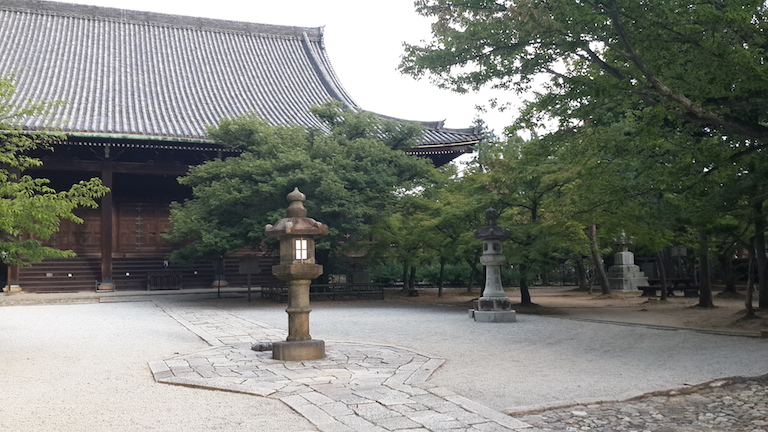There are loads of shrines and temples in Kyoto, so not all of them get the attention from the tourists. This one has just one tourist enjoying it. The door was open, and no one is here to greet me. No ticket booth, no signs saying “do not walk here”, no maintenance men. Just me and cicadas. With the sounds of distant thunder, maybe bringing rain, maybe just “heat” thunder as we used to call it in Michigan summers.
I got here by sheer luck. Eschewing the tourist bus that was recommended, I just started walking and got “lost” in a medium sized neighborhood. I kinda had my compass bearings set for a southeasterly amble, trusting that eventually I would run into the main Marutamachi / Higashioji-dori intersection. Which we all do, at some point in our lives. And I came across this open gate that looked like a driveway into some sort of school. Nothing said “do not enter”, so I entered. And it turned out to be this Yoshida Shrine! (shorter wiki entry in English)\
I know next to nothing about the history of shrines like this. I’ve read a few books, and I know a few facts (mostly about eras, patronage, various deities both Shinto and Buddhist and architecture). But what I am most interested in is what I know least about – the meanings people throughout the century created and reified in Shrines like this one.
And, I can’t ignore this one, I keep thinking of what it was like here during the early 1940s. I KNOW everyone has moved beyond WWII, and I wasn’t even alive then, but after a few days absorbing the history of Hiroshima, knowing Kyoto was on the short list for an A Bomb too, I wonder what life must have been like. How many families in this neighborhood, who asked for safety from this shrine, lost their men to the war? Was this a recruitment center for the armies that fought against the US? After the war, what role did this Shrine play as Japanese society rebuilt it’s entire being? It’s sense of what it meant to be Japanese.
As I’m typing off behind this tree, a Japanese man, middle aged, strides up to the shrine from the gate 100 yards to the left. It’s about 5pm, so maybe he’s coming home from work. He’s dressed in casual light clothing, not a business suit, so maybe he’s retired. He puts his bag down at his feet. Takes off his hat. Stands quietly with eyes closed (yes, I can see all this). He bows slightly. Stands again. Lightly claps his hands twice. Stands again. Seems to be reflecting or deliberating or asking, quietly. After 3-4 minutes he bows again, picks up his bag, and walks off in another direction. I wonder who he is. What he does. What kind of life he has led here, while I have led mine on the other side of the globe. We could be the same age. Curious.
I don’t have any insights or conclusions here. It’s a beautiful, peaceful day in Kyoto, Japan this last day of July, 2014. I’m on a year long trip around the world with some desires and goals, but no real overall agenda. I’m not trying to “find myself”, but I do want to put myself in unfamiliar places for long periods of time to see if more of me emerges, the parts of me that have been quiet for a long time, or maybe forever. There’s a Buddhist homily I really like: the useful part of the bowl is the empty space. I think in this trip I want to create empty space; to let go of old familiar beliefs and limitations and clinging, and then notice what else comes, maybe meekly, to fill it.
So that’s what I ask for today. To create some empty space. And, amid a crowded, frantic city with tens of thousands of tourists clambering to see as many temples as they can…..somehow I found my own, private, quiet, ancient Kyoto Shrine.

East Asia
